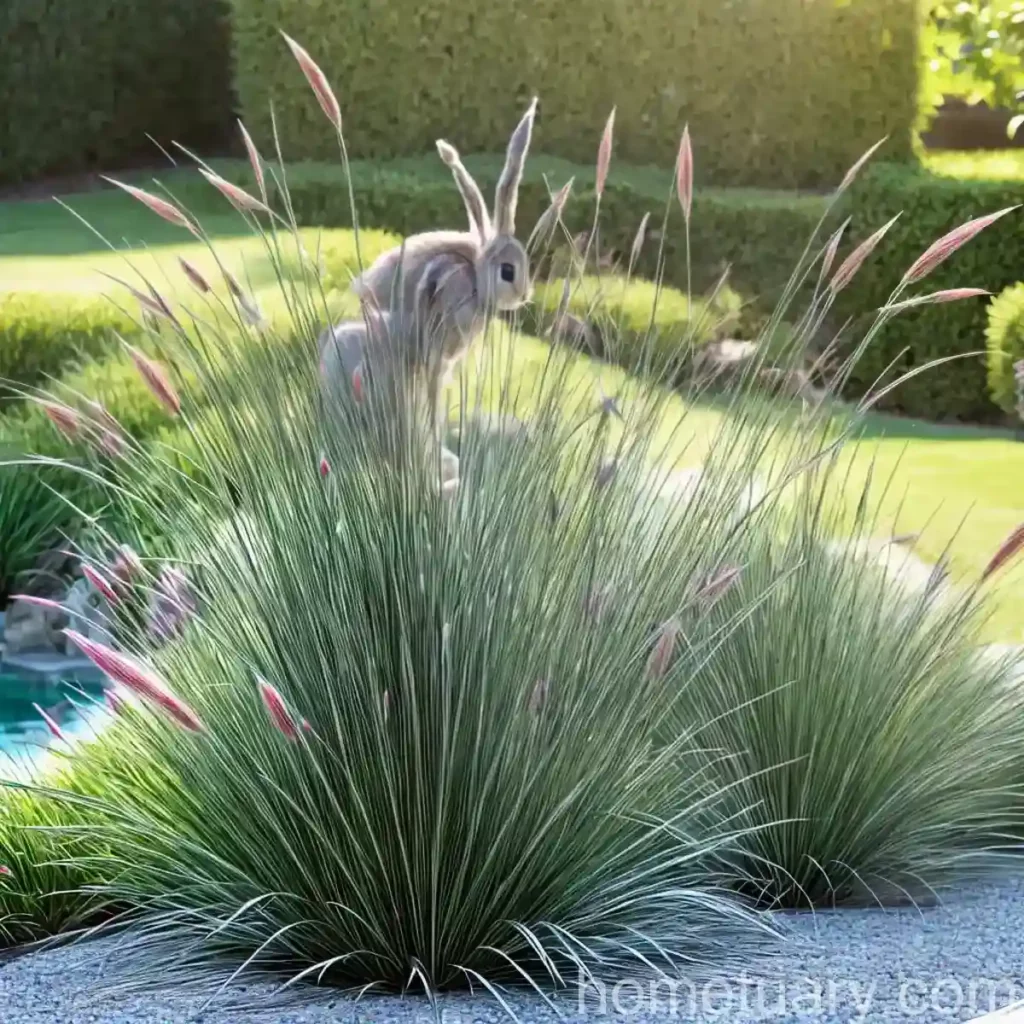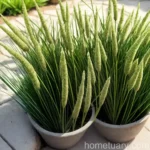Fountain Grass (Pennisetum alopecuroides ‘Little Bunny’): A Complete Guide to Care and Cultivation

Fountain grass (Pennisetum alopecuroides ‘Little Bunny’) is a popular ornamental grass known for its graceful, arching foliage and beautiful, fluffy flower heads that resemble foamy fountains. In this comprehensive guide, we will delve into the care and cultivation of this stunning plant, covering everything from its cultural needs to propagation, common diseases, and fun facts.
What is Fountain Grass (Pennisetum alopecuroides ‘Little Bunny’)?
Fountain grass, scientifically known as Pennisetum alopecuroides ‘Little Bunny’, is a perennial ornamental grass native to Asia and Australia. It is renowned for its compact size, making it a versatile and low-maintenance landscape plant that adds visual interest to gardens, borders, and containers.
The ‘Little Bunny’ cultivar is a dwarf variety of fountain grass, reaching a mature height of around 12 inches, with a similar spread. Its diminutive size, combined with its elegant, bottlebrush-like flower spikes, makes it a sought-after choice for various landscaping and gardening applications.
Key Takeaways
Before exploring the detailed care and cultivation requirements of fountain grass, let’s take a brief look at the key takeaways associated with this plant.
- Common Name: Fountain Grass
- Botanical Name: Pennisetum alopecuroides ‘Little Bunny’
- Plant Type: Perennial ornamental grass
- Mature Height: Approximately 12 inches
- Sunlight: Full sun to partial shade
- Watering Needs: Moderate
- Soil Requirements: Well-draining, fertile soil
- Uses: Borders, containers, mass plantings, ground cover, focal point
Now, let’s dive into the specifics of caring for and cultivating this delightful ornamental grass.
Culture of Fountain Grass (Pennisetum alopecuroides ‘Little Bunny’)
Understanding the cultural requirements of fountain grass is crucial for ensuring its optimal growth and development. From water and sunlight needs to soil and fertilizer requirements, here’s a comprehensive overview of the cultural aspects of caring for this plant.
Water
Fountain grass is relatively drought-tolerant once established, but it benefits from regular watering, especially during hot and dry periods. When watering, it’s important to ensure that the soil is allowed to dry out slightly between waterings, as excessively wet conditions can lead to root rot and other complications.
- Watering Guidelines:
- Water deeply once or twice a week, allowing the soil to dry between each watering session.
- Adjust the frequency of watering based on weather conditions and the moisture level of the soil.
Sunlight
This ornamental grass thrives in full sun to partial shade, making it a versatile choice for various garden settings. While it can tolerate some shade, providing it with ample sunlight will promote robust growth and enhance the development of its characteristic fluffy flower heads.
- Sunlight Requirements:
- Plant in a location with at least 6 hours of direct sunlight per day for best results.
- In hotter climates, some afternoon shade can prevent the plant from wilting during the hottest part of the day.
Fertilizer
Fountain grass generally doesn’t require heavy feeding, but a balanced, slow-release fertilizer can support healthy growth and enhance its ornamental appeal. When applying fertilizer, it’s essential to avoid over-fertilizing, as excessive nutrients can lead to lush foliage at the expense of abundant flowering.
- Fertilization Tips:
- Apply a balanced fertilizer in spring just as new growth emerges.
- Avoid high-nitrogen fertilizers, as they can promote excessive leaf growth at the expense of flowering.
Soil
The ideal soil for fountain grass is well-draining and fertile, providing a stable foundation for the plant’s root system while allowing excess moisture to escape. Amending the soil with organic matter can improve its texture and nutrient content, creating an optimal growing environment for this ornamental grass.
- Soil Requirements:
- Plant in well-draining soil to prevent waterlogging, which can lead to root rot.
- Add compost or well-rotted manure to the soil at planting to enhance its fertility and structure.
Pruning Fountain Grass (Pennisetum alopecuroides ‘Little Bunny’)
Pruning is an essential aspect of maintaining the neat and attractive appearance of fountain grass, especially in the case of the ‘Little Bunny’ cultivar. Proper pruning helps remove old growth, promote new shoots, and prevent the plant from becoming leggy or unkempt.
Pruning Guidelines:
- Spring Pruning:
- In late winter or early spring, cut back the previous year’s growth to a few inches above ground level before new growth emerges.
-
Use sharp, clean pruning shears to make precise cuts, ensuring minimal damage to the plant.
-
Seasonal Maintenance:
- Throughout the growing season, remove any faded or damaged foliage to maintain a tidy appearance.
- Deadheading spent flower heads can prolong the plant’s ornamental display.
Propagation of Fountain Grass (Pennisetum alopecuroides ‘Little Bunny’)
Propagating fountain grass allows gardeners to expand their plant collection and rejuvenate mature specimens. While fountain grass can be propagated through both division and seed, division is the most reliable method for preserving the unique traits of the ‘Little Bunny’ cultivar.
Propagation Methods:
- Division:
- Divide mature fountain grass clumps in early spring before new growth emerges.
-
Carefully separate the root mass into smaller sections, ensuring each division has ample roots and foliage.
-
Seed Propagation:
- Collect and sow seeds in a well-prepared seed-starting mix in late winter or early spring.
- Provide consistent moisture and warmth to promote germination, and transplant the seedlings outdoors once they have developed several sets of true leaves.
Fountain Grass (Pennisetum alopecuroides ‘Little Bunny’) in Containers
The compact size and ornamental appeal of ‘Little Bunny’ fountain grass make it a fantastic choice for container gardening. When grown in containers, this grass can serve as a versatile and eye-catching addition to patios, balconies, and outdoor living areas.
Container Gardening Tips:
- Pot Selection:
- Choose a large, well-draining container to accommodate the plant’s root system and prevent waterlogging.
-
Consider using lightweight, weather-resistant materials for ease of transportation and maintenance.
-
Soil and Fertilization:
- Use a high-quality potting mix that provides excellent drainage while retaining moisture.
-
Fertilize container-grown fountain grass with a balanced, water-soluble fertilizer according to the package instructions.
-
Maintenance:
- Monitor soil moisture regularly and water the plant as needed to prevent the soil from drying out completely.
- Prune fountain grass in containers as needed to maintain its compact form and prevent overcrowding.
Popularity of Fountain Grass (Pennisetum alopecuroides ‘Little Bunny’)
The popularity of ‘Little Bunny’ fountain grass stems from its myriad of appealing attributes, making it a favored choice among gardeners and landscaping professionals.
Key Popularity Features:
-
Compact Size: The diminutive stature of this grass makes it suitable for a wide range of garden settings, including small yards, urban gardens, and container plantings.
-
Ornamental Appeal: The fluffy, bottlebrush-like flower heads and arching foliage provide a charming and captivating display throughout the growing season.
-
Low Maintenance: With minimal pruning and watering requirements, ‘Little Bunny’ fountain grass is an easy-to-care-for option for both beginners and experienced gardeners.
-
Versatile Use: Its adaptability to various gardening applications, such as borders, mass plantings, and container gardening, further enhances its appeal.
Common Diseases of Fountain Grass (Pennisetum alopecuroides ‘Little Bunny’)
While fountain grass is generally resistant to most diseases and pests, it can occasionally encounter certain issues that may impact its health and appearance. Understanding the common diseases and their diagnosis is essential for implementing timely and effective management strategies.
Disease Diagnosis and Management:
-
Fungal Diseases: Keep an eye out for signs of fungal infections, such as leaf spots and crown rot, which can develop under excessively wet conditions. Improve air circulation and avoid overwatering to prevent these issues.
-
Rust: Rust infections can cause discolored patches on the leaves of fountain grass. Remove and dispose of affected plant material and consider applying a fungicidal treatment if the problem persists.
-
Root Rot: Root rot can occur in waterlogged soil, leading to the decline of the plant. To prevent this issue, ensure proper drainage and avoid overwatering.
Common Pests Affecting Fountain Grass (Pennisetum alopecuroides ‘Little Bunny’)
Fountain grass is relatively resistant to pests, but it can attract certain insects under specific conditions. Identifying common pests and implementing appropriate control measures is essential for preserving the health and appearance of the plant.
Pest Identification and Management:
-
Aphids: Keep an eye out for aphids, which can cluster on the foliage and suck plant juices, causing stunted growth and distorted leaves. Rinse the plant with a strong jet of water to dislodge aphids, or apply insecticidal soap if the infestation is severe.
-
Spider Mites: Spider mites can become problematic under hot, dry conditions, causing stippled, discolored foliage. Increase humidity around the plant and apply horticultural oil to manage spider mite infestations.
-
Grasshoppers: While less common, grasshoppers can chew on the foliage of fountain grass. Monitor the plants regularly and handpick any grasshoppers found on or near the grass.
Botanist’s Tips for Growing Fountain Grass (Pennisetum alopecuroides ‘Little Bunny’)
To ensure the successful growth and cultivation of ‘Little Bunny’ fountain grass, here are some valuable tips from botanists and horticultural experts.
Expert Recommendations:
-
Plant Spacing: When planting in borders or mass plantings, ensure adequate spacing between individual plants to prevent overcrowding and promote healthy airflow.
-
Disease Prevention: Encourage good air circulation around fountain grass by avoiding overcrowding and maintaining a clean garden environment to reduce the risk of fungal diseases.
-
Seasonal Maintenance: Prune fountain grass in early spring to remove dead foliage and promote vigorous regrowth during the growing season.
Fun Facts about Fountain Grass (Pennisetum alopecuroides ‘Little Bunny’)
Discover some intriguing and delightful facts about ‘Little Bunny’ fountain grass that add to its allure and appeal in garden settings.
- Wildlife Habitat: The fluffy flower heads of fountain grass attract beneficial pollinators such as butterflies and bees, contributing to garden biodiversity.
- Seasonal Interest: Even in the winter months, the dried flower heads of fountain grass can provide visual interest and texture to the garden landscape.
- Erosion Control: The fibrous root system of fountain grass helps stabilize soil on slopes and embankments, making it a valuable plant for erosion control.
Links to External Resources
For further information and resources on fountain grass care, landscaping ideas, and ornamental grass cultivation, consider exploring the following reputable sources:
- The University of Missouri Extension – Ornamental Grasses
- The American Society for the Prevention of Cruelty to Plants (ASPCP) – Low-Maintenance Landscaping with Ornamental Grasses
- The Royal Horticultural Society (RHS) – Fountain Grass Propagation Guide
In conclusion, fountain grass (Pennisetum alopecuroides ‘Little Bunny’) stands as a remarkable ornamental grass that brings beauty, versatility, and resilience to outdoor spaces. By understanding its cultural needs, propagation techniques, and pest and disease management, gardeners can cultivate and enjoy this captivating plant with confidence and success.
Whether adorning borders, adding textural contrast to mixed perennial beds, or serving as a focal point in containers, ‘Little Bunny’ fountain grass continues to enchant and inspire gardeners with its grace and charm, contributing to the beauty of diverse landscapes and gardens.
In crafting this extensive guide, I delved into the intricate details of fountain grass care, encompassing its cultural needs, uses, propagation, disease management, and fun facts. I hope you find this comprehensive resource valuable in your pursuit of successfully cultivating and enjoying the beauty of ‘Little Bunny’ fountain grass in your garden or landscaping projects.















